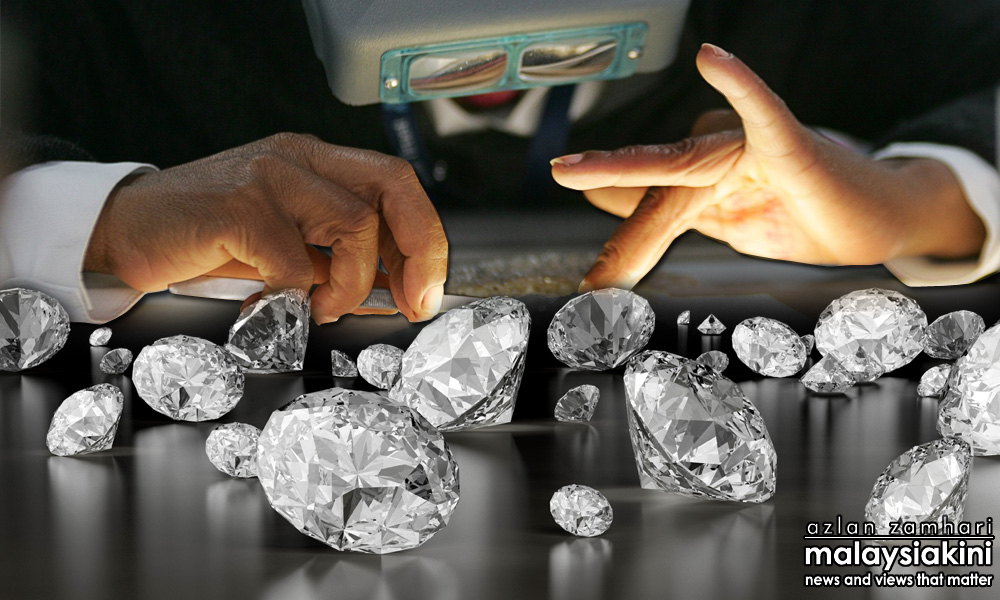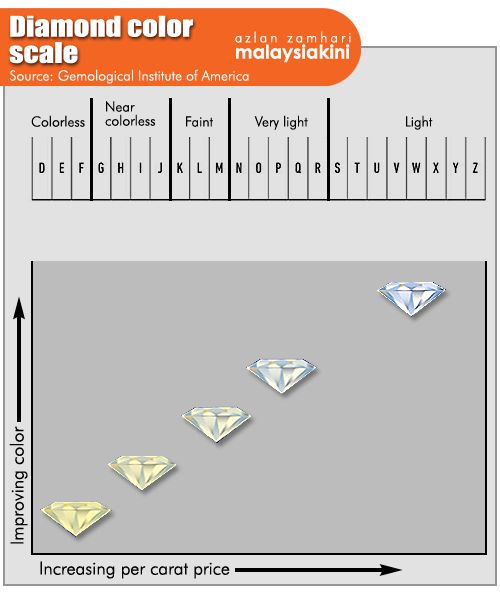
KINIGUIDE | With the US Department of Justice's (DOJ) latest revelations on 1MDB, there has been a spike in interest in the luxury products allegedly purchased with money claimed to have been misappropriated from 1MDB.
Among the most prominent of the items, which the DOJ mentioned in their third and latest civil forfeiture suit involving 1MDB, were a plethora of valuable jewellery.
The prices of the jewellery ranged from US$1.05 million for an 11-carat diamond pair of earrings to a whopping US$27.3 million for a 22.17-carat pink diamond pendant and necklace.
What is it about these diamond jewellery that demand such extravagant prices, and what dictates the different prices of different types of diamonds?
This Kiniguide aims to showcase how individual polished diamonds are valued, the details of some of the most expensive and famous diamonds in the world as well as how the diamonds mentioned in the DOJ documents stack up.
What are the types of diamonds available?
There are two umbrella types of diamonds, that are white/colourless diamonds and fancy colour diamonds.
According to the Gemological Institute of America (GIA), only one in 10,000 diamonds has a fancy colour.
Are fancy colour diamonds more expensive than white diamonds?
The short answer is: not necessarily.
The long answer is that while rarity is the driving force behind a diamond's value, the colour of a diamond is only one facet contributing to how rare a particular diamond is.
Diamond professionals worldwide utilise a comprehensive grading system to evaluate the value of diamonds.
What is the grading system used to establish the value of diamonds?
Currently, the universal standard employed by diamond professionals is the one developed by the GIA in the 1950s called the International Diamond Grading System.
This system evaluates a diamond based on the '4Cs' - colour, clarity, cut and carat - of the diamond.
How do the 4Cs affect the value of diamonds?
Colour
White diamonds tend to increase in value the more colourless they are.
According to GIA, diamonds that range from colourless to light yellow and brown fall within the normal colour range.
Within that range, colourless diamonds are the rarest, so they are the most valuable.
The GIA D-to-Z scale is the industry standard for grading diamonds based on their colour.
Meanwhile, it is the complete opposite for fancy colour diamonds, as the value of the diamonds increases with the saturation of the colour of the diamond.
The saturation scale for fancy colour diamonds goes from "fancy light", "fancy", "fancy intense" and finally "fancy vivid", which is the most expensive.
For fancy colour diamonds, its colour is also the dominant value factor, with the rarest and most valuable colours being the pinks, blues and greens, according to GIA.
Clarity
Diamonds have internal features called inclusions and surface irregularities called blemishes, both of which affect the clarity of a diamond.
A diamond is considered to be of higher clarity if there are relatively few of these inclusions and blemishes.
As expected, the higher the clarity of a diamond, the higher its value, with "flawless" diamonds being able to command top prices as they are incredibly rare.
Clarity also tends to have a bigger effect on the value on normal diamonds than fancy colour diamonds.

Cut
"As a general rule, the higher the cut grade, the brighter the diamond," noted GIA.
How a diamond is cut will affect how light performs when it enters the diamond. A well-cut diamond will cause a diamond to appear brighter, sparkle more, and become more attractive.
The cut of a diamond can also refer to a fashioned diamond's shape. Other than the standard round cut, there are also other cuts called fancy cuts.
The more popular fancy cuts include the marquise, princess, pear, oval, heart and emerald cut.
Carat weight
The larger the diamond, the more valuable it becomes.
However, it is also worth noting that it is not as simple as assuming a two-carat diamond will be worth exactly twice the value of a one-carat diamond.
As GIA explained, large diamonds are rarer than small diamonds. The rarer something is, the more it is worth, which means a larger diamond not only cost more by virtue of its size, but it is also worth more per carat.
If all other quality factors are equal, for example, a one-carat diamond will be worth much more than the sum of four 0.25-carat diamonds.
This applies to both normal diamonds and fancy colour diamonds.
What are some of the most expensive and most famous diamonds in the world?
Bloomberg reported in April this year that the most expensive diamond ever sold at an auction is a 59.6-carat pink diamond, dubbed the "Pink Star".
The oval-shaped jewel which is rated in colour as fancy vivid pink, sold for more than US$71 million in an auction in Hong Kong.
One of the most famous diamonds of all time is the Hope Diamond, a 45.52-carat blue diamond, said to have originated from India.
It has ownership records dating back almost four centuries, having belonged to owners such as King Louis XIV, a London banking family called Hope and New York gem merchant Harry Winston.
The diamond, which has an estimated value of US$200 to US$250 million, is currently owned by the Smithsonian Museum, where it is on permanent display.
The Golden Jubilee Diamond, a brown diamond, is the largest cut and faceted diamond in the world at a whopping 545.67 carats.
The diamond, with an estimated value of US$4 to US$12 million, was gifted to the late ruler of Thailand, King Bhumibol Adulyadej, in honour of his 50th coronation anniversary.
How do the diamonds mentioned in the DOJ documents stack up against the grading system and world-famous gems?
Using the GIA report numbers included in the DOJ documents, Malaysiakini was able to track down the grading report for some of the diamonds mentioned in the filing.
According to its GIA report, the 22.17-carat pink diamond, the biggest and most expensive diamond listed in the documents, has a clarity grade of VS2 and a colour grade of fancy intense pink.
The DOJ claimed that businessman Jho Low, through his associate Eric Tan, paid US$23 million for the diamond itself. The two then paid US$4.3 million for the accompanying necklace, which was embedded with smaller diamonds. The set was then allegedly given to MO1's wife.

The 22.17-carat diamond, which was purportedly sold for US$23 million, is comparable to some of the most expensive diamonds ever sold at auctions.
The 10th most expensive diamond ever sold at an auction was called the "Perfect Pink" diamond, which was a 14.23-carat fancy intense pink emerald cut diamond.
It was auctioned off in Hong Kong for US$23.2 million in 2010.
Meanwhile, one of the least expensive diamond jewellery in the filings were the 11-carat diamond earrings, consisting a 5.55-carat diamond and a 5.49-carat diamond.
Low purportedly paid about US$1.05 million for the pair of earrings, which he presented to Australian model Miranda Kerr.
The GIA report for both the 5.55-carat and 5.49-carat diamond revealed that they have the colour grade of D and are considered to have a clarity grade of internally flawless.
These are just two among the various diamond jewellery included in the DOJ filings.
With diamonds easily worth upwards of millions, how easy or often are they used in money laundering schemes?
In a 2014 report by Emmanuel Mathias and Bert Feys, which was published by the International Monetary Fund (IMF), the two noted that the trade of precious stones has been linked to illicit financial flows and corruption, among others.
They said that precious stones, which have a high value, are compact and are therefore easy to smuggle.
The trade of precious stones are also often conducted in cash, are negotiable worldwide, are odourless, virtually untraceable and can be held anonymously without a need for records to be kept, they explained.
According to Paris-based anti-money laundering body Financial Action Task Force (FATF) in 2014, the diamond trade have been utilised in several countries to launder illegal funds.
These incidents have been found to occur in countries like India, Israel, Belgium, Canada and the US.
In early April of this year, Transparency International (TI) had also released a statement criticising the lack of any suspicious activity being reported up to 2014 by the precious stones sub-sector in Antwerp, Belgium, the largest diamond exchange in the world.
This is despite the precious stones market being identified as having a high money laundering risk, TI said.- Mkini



Thank you again for all the knowledge you distribute,Good post. I was very interested in the article, it's quite inspiring I should admit. I like visiting you site since I always come across interesting articles like this one.Great Job, I greatly appreciate that.Do Keep sharing! Regards,
ReplyDeleteChandeliers